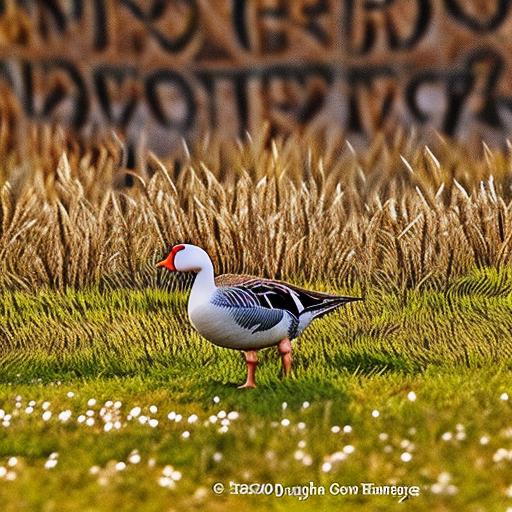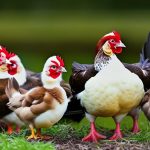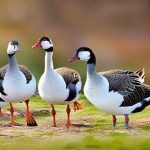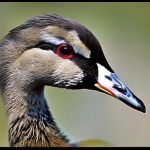Geese infestation can be a major problem for property owners, especially those who live near bodies of water or open fields. These birds are attracted to certain areas due to the availability of food and nesting sites. Their presence can cause damage to lawns, gardens, and even pose health risks due to their droppings. In order to effectively deter geese, it is important to understand their behavior and implement various methods that discourage them from staying in an area. This post will discuss different methods that can be used to deter geese, including physical barriers, visual deterrents, sound-based deterrents, removing food sources, installing motion-activated sprinklers, using scarecrows or decoys, planting geese-resistant vegetation, seeking professional help, and consistent monitoring and maintenance.
Key Takeaways
- Geese are territorial and protective of their young, which can lead to aggressive behavior towards humans.
- Physical barriers such as fences or netting can prevent geese from accessing certain areas.
- Visual deterrents like decoys or reflective tape can make geese feel uncomfortable and discourage them from staying in an area.
- Sound-based deterrents like loud noises or predator calls can also be effective in scaring geese away.
- Removing food sources like grass clippings or pet food can make an area less attractive to geese.
Understanding the Behavior of Geese
Geese are attracted to certain areas for several reasons. One of the main reasons is the availability of food. Geese are herbivores and feed on grasses, grains, and aquatic plants. They are particularly attracted to areas with lush green grass and open spaces where they can easily access food sources. Geese are also attracted to areas with water bodies nearby as they provide a source of drinking water and protection from predators.
Understanding the nesting and feeding habits of geese can help in deterring them effectively. Geese typically nest near water bodies, such as ponds or lakes. They prefer areas with tall grasses or shrubs where they can build their nests and raise their young. By removing or trimming these vegetation types near your property, you can discourage geese from nesting in the area.
Creating Physical Barriers
Physical barriers can be an effective way to deter geese from entering certain areas. There are different types of barriers that can be used, such as fences, netting, or hedges. Fences should be at least three feet high and have small openings to prevent geese from squeezing through. Netting can be used to cover areas where geese are likely to feed, such as gardens or lawns. Hedges can also be used as a natural barrier to prevent geese from accessing certain areas.
When installing physical barriers, it is important to ensure that they are properly maintained. Regularly check for any gaps or damage in fences or netting and repair them immediately. Trim hedges regularly to prevent geese from using them as nesting sites. By creating effective physical barriers, you can significantly reduce the presence of geese on your property.
Using Visual Deterrents
Visual deterrents can be an effective way to deter geese by creating an environment that they find unappealing or threatening. Scarecrows are a common visual deterrent that can be used to scare away geese. Place scarecrows in areas where geese are likely to feed or nest, such as gardens or lawns. Move them regularly to prevent geese from becoming accustomed to their presence.
Reflective tape is another visual deterrent that can be used to deter geese. Hang strips of reflective tape in areas where geese are likely to gather, such as near water bodies or feeding areas. The movement and reflection of the tape can create an unsettling environment for the geese and discourage them from staying in the area.
Implementing Sound-Based Deterrents
Sound-based deterrents can be an effective way to deter geese by creating a noisy and threatening environment. There are different types of sound-based deterrents that can be used, such as noise makers and predator calls. Noise makers, such as air horns or whistles, can be used to scare away geese when they approach certain areas. Predator calls, such as recordings of bird distress calls or barking dogs, can also be effective in deterring geese.
When using sound-based deterrents, it is important to vary the sounds and patterns to prevent geese from becoming accustomed to them. Place the noise makers or predator calls in areas where geese are likely to gather or feed, and activate them when geese are present. By implementing sound-based deterrents, you can create an environment that is unappealing and threatening to geese.
Removing Food Sources

Removing food sources is an important step in deterring geese from staying in an area. Geese are attracted to areas with abundant food sources, such as grasses, grains, and aquatic plants. By removing or reducing these food sources, you can discourage geese from staying in the area.
Regularly mow lawns and trim grasses to reduce the availability of food for geese. Remove fallen fruits or seeds from gardens or lawns to prevent geese from feeding on them. If you have a pond or lake on your property, consider installing a fountain or aerator to disrupt the growth of aquatic plants that geese feed on. By removing food sources, you can make your property less attractive to geese.
Installing Motion-Activated Sprinklers
Motion-activated sprinklers can be an effective way to deter geese by creating a sudden burst of water when they approach certain areas. Geese are startled by the sudden spray of water and are discouraged from staying in the area. Install motion-activated sprinklers in areas where geese are likely to gather or feed, such as gardens or lawns.
When installing motion-activated sprinklers, it is important to position them strategically to cover the desired area. Adjust the sensitivity and range of the sprinklers to ensure that they are triggered when geese approach. Regularly check and maintain the sprinklers to ensure their effectiveness. By installing motion-activated sprinklers, you can create a deterrent that is both effective and environmentally friendly.
Using Scarecrows or Decoys
Scarecrows or decoys can be an effective way to deter geese by creating the illusion of a predator in the area. Geese are naturally wary of predators and will avoid areas where they perceive a threat. Place scarecrows or decoys in areas where geese are likely to gather or feed, such as gardens or lawns.
When using scarecrows or decoys, it is important to move them regularly to prevent geese from becoming accustomed to their presence. Change the position or appearance of the scarecrows or decoys to create the illusion of movement and increase their effectiveness. By using scarecrows or decoys, you can create a deterrent that is both effective and visually appealing.
Planting Geese-Resistant Vegetation
Planting geese-resistant vegetation can be an effective way to deter geese by providing them with less appealing food sources. There are different types of vegetation that geese are less likely to eat, such as ornamental grasses, shrubs with thorns, or plants with strong odors. Plant these types of vegetation in areas where geese are likely to feed, such as gardens or lawns.
When planting geese-resistant vegetation, it is important to choose species that are suitable for your climate and soil conditions. Regularly maintain and prune the vegetation to ensure its health and effectiveness as a deterrent. By planting geese-resistant vegetation, you can provide an alternative food source for geese and discourage them from staying in the area.
Seeking Professional Help
If the geese infestation on your property is severe or persistent, it may be necessary to seek professional help. Professional wildlife control experts have the knowledge and experience to effectively deter geese and prevent further damage to your property. They can assess the situation, recommend appropriate deterrent methods, and implement them effectively.
When seeking professional help, it is important to find a reputable and licensed wildlife control expert. Ask for recommendations from friends or neighbors who have dealt with similar issues. Research different companies and read reviews or testimonials to ensure their credibility. By seeking professional help, you can ensure that the geese infestation on your property is effectively addressed.
Consistent Monitoring and Maintenance
Consistent monitoring and maintenance are essential to ensure the effectiveness of the deterrent methods used. Regularly check for any signs of geese activity, such as droppings or feathers, and take appropriate action to deter them. Inspect physical barriers, visual deterrents, sound-based deterrents, and other methods regularly to ensure that they are functioning properly.
Maintain and repair physical barriers, such as fences or netting, as needed. Move scarecrows or decoys regularly to prevent geese from becoming accustomed to their presence. Replace batteries or adjust settings on motion-activated sprinklers or noise makers to ensure their effectiveness. By consistently monitoring and maintaining the deterrent methods used, you can effectively deter geese from your property.
Geese infestation can be a major problem for property owners, but there are effective methods that can be used to deter them. By understanding the behavior of geese and implementing various deterrent methods, such as physical barriers, visual deterrents, sound-based deterrents, removing food sources, installing motion-activated sprinklers, using scarecrows or decoys, planting geese-resistant vegetation, seeking professional help, and consistent monitoring and maintenance, you can significantly reduce the presence of geese on your property. Take action today to deter geese and protect your property from damage and health risks.
If you’re looking for more information on how to keep geese out of your yard, you might also be interested in learning about the incubation period for goose eggs. Understanding this process can help you better manage geese populations and prevent them from nesting in your yard. Check out this informative article on Poultry Wizard: “What is the Incubation Period for Goose Eggs?” It provides valuable insights into the breeding habits of geese and offers practical tips for dealing with them. Read more here.
FAQs
What are some common problems caused by geese in yards?
Geese can cause damage to lawns, gardens, and landscaping. They can also leave behind droppings that are unsightly and can carry diseases.
What are some natural ways to keep geese out of your yard?
Planting tall grasses or shrubs around the perimeter of your yard can deter geese from entering. You can also use decoys of natural predators, such as coyotes or foxes, to scare geese away.
What are some non-natural ways to keep geese out of your yard?
Installing fencing or netting around your yard can prevent geese from entering. You can also use noise deterrents, such as loud music or clapping, to scare geese away.
Is it legal to harm or kill geese to keep them out of your yard?
No, it is illegal to harm or kill geese without a permit. There are humane ways to deter geese from entering your yard without causing harm to the birds.
What should I do if I have a persistent geese problem?
Contact your local wildlife agency or animal control for assistance in dealing with a persistent geese problem. They can provide advice and resources for humane ways to deter geese from entering your yard.
Meet Walter, the feathered-friend fanatic of Florida! Nestled in the sunshine state, Walter struts through life with his feathered companions, clucking his way to happiness. With a coop that’s fancier than a five-star hotel, he’s the Don Juan of the chicken world. When he’s not teaching his hens to do the cha-cha, you’ll find him in a heated debate with his prized rooster, Sir Clucks-a-Lot. Walter’s poultry passion is no yolk; he’s the sunny-side-up guy you never knew you needed in your flock of friends!







